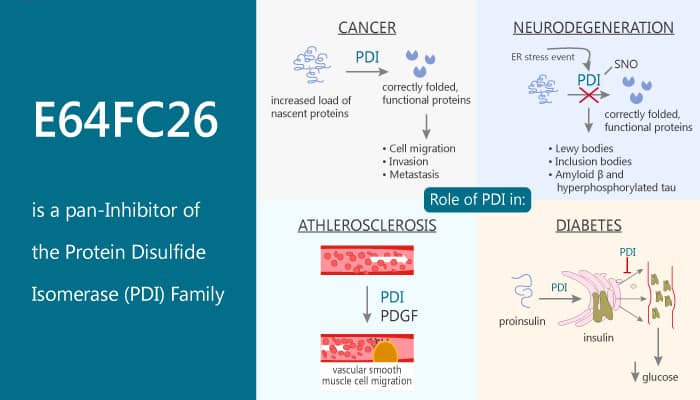Multiple myeloma (MM) is an incurable hematological malignancy. MM results in the accumulation of clonal plasma cells within the bone marrow. The natural biology of the plasma cell makes MM uniquely sensitive to disruptions in protein homeostasis. Subsequently, it proposes targeting protein folding as a strategy for the treatment of cancer. It includes the inhibition of molecular chaperones like HSP90 and the inhibition of protein disulfide isomerase (PDI). PDIs are a family of more than 20 ER-resident oxidoreductase enzymes. PDI catalytic activity is redox dependent, involving the oxidation of thiols on un/misfolded protein substrates. PDI activity is involved in multiple diseases, including neurodegenerative disorders like Huntington’s, Alzheimer’s, Parkinson’s disease, thrombosis, HIV infection, and cancer. In this study, E64FC26 is a potent pan-inhibitor of the protein disulfide isomerase (PDI) family. Moreover, it shows anti-myeloma activities.

E64FC26 is a potent pan-inhibitor of the protein disulfide isomerase (PDI) family with anti-myeloma activities.
E64FC26 shows IC50s of 1.9, 20.9, 25.9, 16.3, and 25.4 μM against PDIA1, PDIA3, PDIA4, TXNDC5, and PDIA6. E64FC26 shows anti-MM activity, with an EC50 of 0.59 μM. Furthermore, E64FC26 is more cytotoxic against a genetically diverse panel of MM cell lines when compared to non-malignant cells. The panel cells include KMS11, OPM2, MM.1S BzR, MM.1S, SA-13, U266 BzR, ANBL6, KMS12PE, U266, 8226 DxR, 8226 BzR, KMS12BM, H929, and 8226 cells.
E64FC26 shows an anti-MM effect in the NSG mice model and increases median survival by 2 weeks. In addition, the combination of E64FC26 and Bortezomib produces the greatest improvement in survival, extending the median survival by 20 days. Meanwhile, E64FC26 demonstrates adequate oral bioavailability of 34% with systemic exposure approaching a maximum concentration (Cmax) of 400 nM in CD-1 mice. Moreover, E64FC26 treatment induces an immediate anti-MM response, decreasing serum M-protein in all mice by an average of 33 ± 7.9%.
In summary, E64FC26 has the potential to be an early drug candidate and the strategy of targeting multiple PDI isoforms for the treatment of refractory MM and beyond.
Reference:
Robinson RM, et al. 2019 Apr;33(4):1011-1022.